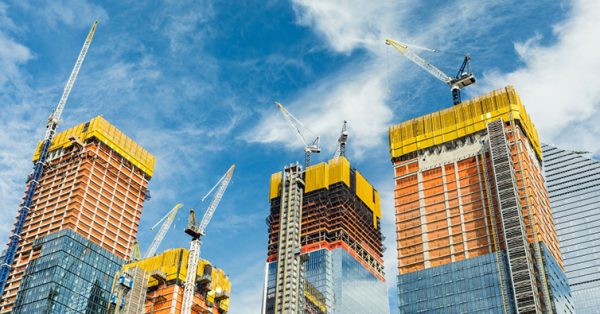As part of the 23rd annual West Coast Casualty’s Construction Defect Seminar (WCCCDS), a panel of longtime insurance professionals hosted a lively discussion on the history of construction defect litigation, as well as the emerging trends they see moving forward. The panelists included Michael Daoussis, Susan Bryan, George Dale, Carol Fleischmann, Robin Kahn, Steve Lokus, Phyllis Modlin, Terri Moran, Karen Rice, Lee Wright — a veritable “Who’s Who” of the construction insurance industry.
We’ll leave the historical component of the talk for another time, and instead focus on the construction law and insurance trends emerging in 2016 that will impact the industry for years to follow.
Megatrends in U.S. Construction Law and Insurance
Construction spending is at its highest level since 2006, and improvement can be seen in all major sectors. Residential construction is almost exclusively focused on apartments, with little to no for-sale housing. Hot markets right now include office and manufacturing in the South, apartments and renovations on the East Coast, while commercial wraps are trending for the apartments and offices under construction radiating out from downtown San Francisco into Silicon Valley.
Not enough “shovel-ready land” combined with increased regulation and demand for sustainability is leading to a nationwide increase in renovation and repositioning of older existing buildings. Renovation, specifically the conversion of one use to another, is a touchy subject for carriers that have been burned by condo conversion markets and the inevitable cutting of corners that seem to go with that process. Aging infrastructure across the nation is also leading to an uptick in claims.
All major insurance carriers’ employee data analysts are leveraging the kernels of truth buried within the mountains of so-called “Big Data” to be found in various policies and claims. As a result, underwriters are becoming more efficient and their risk selection schemes more sophisticated. By analyzing data collected by third-party QA/QC providers, insurance carriers can make fairly educated guesses about future potential losses. The biggest drawback to this approach is that data scientists must analyze historical information which often includes things that are now excluded by the updated policy language. As such, panelists state that there is still “too much art in construction defect claims” to fully automate accurate defect claim predictions. (That’s why early case evaluation is still so critical for insurance claims professionals and legal counsel alike.)
One important trend: insurance professionals report that the historically strained or non-existent relationships between underwriters and claims professionals are improving, and underwriters are more frequently asking claims adjusters to provide input on policy renewals.
Trends in the Types of Construction Claims
- Apartment project owners filing claims more often against a GC that is their own entity
- Condo conversion claims continue but not expected to trend upward
- Claims by owners of large custom homes increasing
- Softer market: broadening of policy terms
- Underwriters now asking for QA on apartments
- 2nd, 3rd, 4th generation defect claims
- Sprinkler systems are the next hot class action claims
- More defect cases going to trial/arbitration
- Mediations more focused on coverage versus liability and damage issues
Trends in Commercial Construction
- Skilled labor going to governmental jobs rather than into construction
- San Francisco is a very difficult and risky marketplace
- More tall buildings which mean new design and construction methods
- The “great glass elevator” which doesn’t use cables is under development
- High-rise wood frame buildings being approved by more code jurisdictions
- Building “health” is a major factor in new construction
- Urban micro apartments and tiny houses
- More light, more windows, equals new leaks
- Increased use of technology including pre-fab/off-site construction, paperless environments/3D printing, laser scanning, IoT/smart/internet-enabled building components
- Should therefore OCIPs/Wraps include manufacturers?
- Drone coverage is now a thing, and is used for monitoring quality, endorsements available which is important because there is an aviation exclusion on the CGL policy
- Phyllis Modlin stated, “looking ahead, we have to expand our notion of what construction litigation looks like”
Trends in Residential Construction
- Weather resistance
- Increase in composite materials which are more lightweight and stronger
- Metropolitan living
- Green construction claims can cost 30-50% more
- False advertising type claims resulting from green methods
- Labor shortage even more severe – could robotics be an answer, not just for labor shortage but for CD claims in general?
- Key markets face a housing shortage
- Number of living units in NE went up 65%, midwest went up 68%, south up 26%, west only up 15%
- Mortgage applications spiked up 24% in February
- The housing market in San Diego alone is short 150,000 units with few options for new development
- New home construction only seeing slight improvement – multifamily is way up
- Chinese developers active in major US markets – Landsea Holdings is biggest one, tied closely to H-1B Visas
- Japanese and Chinese bidding war in Hawaii increasing homelessness
- Condo conversions – not now, maybe soon?
- Lots of mixed-use developments
To learn more about VERTEX’s services or to speak with an Expert, call 888.298.5162 or submit an inquiry.
This article was originally published by Xpera Group which is now part of The Vertex Companies, LLC.





